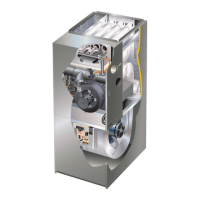pressure build-up. Causes of discharge
can
be
thermal
expansion, excess system pressure, too high a temperature
setting
on
the thermostat or something
in
the water heater
causing excess temperatures
in
the heater.
Thermal
Expansion
When water
is
heated it expands. For example,
in
a 40-gal-
Ion
water heater, water being heated to its thermostat set-
ting will end
up
expanding by approximately 1/2 gallon. This
extra volume created by the expansion
has
to
go
some-
where or pressure will dramatically increase, such
as
when
water
is
heated
in
a closed system. A good indication of
thermal expansion
is
when the T&P valve releases about
one cup of water for every 10 gallons of heater capacity with
each heating cycle. The T&P valve is functioning properly
when it relieves pressure caused by thermal expansion, but
frequent relief
can
result
in
a build
up
of natural mineral
deposits
on
the valve seat, rendering the valve inoperative.
Should this happen, the T&P valve needs
to
be
replaced.
To
prevent this
T&P
VALVE' from discharging hot water, the
loss of energy and reduce the possible build-up of lime
in
the
T&P
VALVE' there are two
(2)
recommendations:
OPTION 1: Install a 125
psi
Pressure Relief (only) valve
in
the cold water supply line. Make sure that the discharge
of
this valve
is
directed to a drain to prevent water damage and
it
is
protected from freezing,
OR
OPTION 2: Install
an
expansion tank
on
the cold water sup-
ply line. For every
50
U.S. gallons
of
stored water, the
expansion tank must have a minimum capacity of 1.5
U.S.
gallons.
Temperature
Relief
The T&P valve will discharge varying amounts
of
water, but
typically more than you would experience from thermal
expansion. Check the temperature
in
relation to the setting
on
the thermostat dial. A malfunctioning thermostat could
cause the water to get too hot.
-9-

